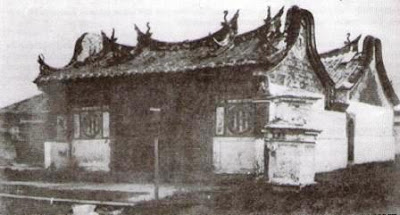Brunei's First Chinese Temple
 The Chinese Temple at Jalan Kianggeh attracted a lot of Brunei photobloggers during its annual Chinese New Year celebrations. It has been there for so long that not many remembered that there is an older one in the city centre.
The Chinese Temple at Jalan Kianggeh attracted a lot of Brunei photobloggers during its annual Chinese New Year celebrations. It has been there for so long that not many remembered that there is an older one in the city centre.I remembered looking at an old photograph of the wharf and seeing an old temple there. When I asked around, most elderly Kampong Ayer folks remember that until about 1960, there was a Chinese temple was there. It was demolished around then and not just the temple, a few of the government buildings around the area were also demolished to make way for the expanding port. The Brunei Port was the one in the city centre until Muara Port was operational in about 1972.
According to a research paper I came across, this first Chinese Temple was built in 1918. As the first World War raged on in Europe, apparently times were good for the Chinese towkays in Brunei. The Chinese businessmen were among the first to heed the British Resident's call to set up shops away from the Kampong Ayer. The original town centre on Kampong Ayer then was Kampong Bakut China, now known as Kampong Pekan Lama. The Chinese community then, mostly Hokkien from the Island of Quemoy were engaged in 'revenue farms' - agricultural areas let by the British Resident to grow cash crops such as tobacco and opium as well as do business including spirits, kerosene and matches. They were also engaged in amassing land especially rubber plantations and also rice plantations. So, it was a prosperous time for the community.
In 1918, Dato Cheok Boon Siok was the Dato Temenggong and he owned land and shophouses up and down the street now known as Jalan Sultan. The site chosen in front of Brunei River was geomantically suitable and owned by him which he donated to the building of that first temple. The temple when it was built was considered as a remarkable piece of architecture and cost around $8,075.50 (Straits Dollar) which is a considerable sum in those days. The money came from donations from shops and individuals in Labuan, Limbang and Brunei as well as levies on tobacco and white rice imports. The top contributor was a shop named Choon Guan.
The temple was named Teng Yun Temple (Temple of Flying Clouds) but it became better known as Twa Pa Kung Temple (Great Uncle Temple). The new temple in Jalan Kianggeh is also known officially as the Hall of Flying Clouds. The temple survived the bombings of the Second World War but by then the need of the expanding port led the government to acquire the area of the temple and that was when the temple was demolished and a new one is built where it is currently. The government provided $45,000 to the building of the new temple in 1960.


Comments
After the temple was built, a plaque was put up with the list of people who donated towards the construction. The plaque was made of wood, roughly 3 foot high and 8 foot wide and inscribed with the names of donors and the amount of their largesse in Chinese and cut into the wood with a blade. Years later, apparently there was a bitter dispute and someone took a saw an cut away a chunk of the plaque. The plaque is now tucked away in a quiet corner of the current temple.
The second story is that the temple was the only large building standing after the bombardments of Brunei Town in World War 2, first by the Japanese and Allies. My uncle remembers after the second bombing people were amused to find an unexploded bomb in the temple courtyard.
Maybe of interest to you.